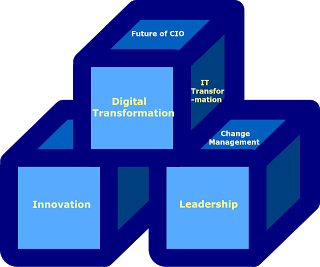Celebrating the 3500th Blog Posting: The Thoughts and Quotes to Highlight the “Future of CIO” Blog
 It’s the beginning of the new month in the new year, it is also the time to celebrate the 3500th blog posting of the “Future of CIO.” Blogging is the practice to keep “digital fit” which is the good balance of the fitting attitude and “misfit” thinking. Blogging is the way to sowing creativity seeds and grow innovation fruits. The content richness is not for its own sake, but to convey the vision and share the wisdom. Here are some thoughts and quotes to highlight the key message of the “Future of CIO” blog, with the slideshare presentation.
It’s the beginning of the new month in the new year, it is also the time to celebrate the 3500th blog posting of the “Future of CIO.” Blogging is the practice to keep “digital fit” which is the good balance of the fitting attitude and “misfit” thinking. Blogging is the way to sowing creativity seeds and grow innovation fruits. The content richness is not for its own sake, but to convey the vision and share the wisdom. Here are some thoughts and quotes to highlight the key message of the “Future of CIO” blog, with the slideshare presentation.
Digital Transformation: Transformation seeks to change. The word "transformation" in itself means change and change for the better, the new ways and methods of doing things, new structures, new relationships, new capability, etc. Digital transformation is non-stoppable.
Going digital not only means to convert traditional business processes, more about the digital shift of soft factors such as the mindset, leadership, and culture.
We are at the dawn of the digital transformation - the change from one era to another is often called, "PARADIGM SHIFT."
Digital Master refers to those high-performing, high-innovative and high-mature digital organizations or individuals.
Digital Transformation for businesses intends to achieve the new level of efficiency and lead to the next level of innovation.
The most effective digital workplace is one where collaboration and sharing are the norms. Digital organization Enforces the Dot-Connecting Culture.
Innovation: Innovation comes from the Latin, "Innovare" - 'to change or alter things that already exist'. The difference between innovation and creativity is implementation. One of the good definitions of innovation is: "to transform the novel ideas into commercially successful products & achieving its business values.”
Digital innovation is benefiting the widest possible audience within your organizational ecosystem.
Innovation = f(Invention, Commercialization).
An innovation ecosystem is a systematic innovation methodological environment or a sort of innovation philosophy.
Open innovation starts with an open mindset and disciplined approaches.
From incremental to breakthrough, innovation is a continuous journey.
Leadership: The function of leaders is to LEAD- set direction, drive changes, make influences, foster motivation, guide the problem solving. Leadership is not just about the title only, that all of us, to the degree, we take responsibility for our own sphere of influence, no matter what formal title we might hold or not, have the opportunity to lead at the different level and exercise leadership influence continually.
Digital leadership must be extremely visionary, empathetic, generous, conscious, passionate, and humble.
Chief influence officer is one of the most pertinent personas for CIO in the 21st century since technology is ubiquitous in the digital era.
Great CIOs are multi-dimensional thinkers and versatile digital leaders.
It's possible for a dynamic, driven CIO to build a professional image as a digital visionary and transformative business leader.
With more advanced management approach and technologies, IT is moving up its maturity from functioning, to firm to delight.
IT Transformation: IT transformation is an integral part of the digital transformation. Many IT organizations are on the inflection point for digital transformation, to transform from a cost center to a growth engine, from a back office function to a digital brain front yard, and from a help desk to an innovation hub.
It is in the tipping point that top performing companies see IT as an asset, capital, and source of competitive advantage.
There is no one size fits all formula to run a high effective IT, different IT organizations and enterprise as a whole are at the different stage of the business maturity.
Running IT as a digital forerunner doesn’t mean IT always lead above or act ahead, it means IT should always think ahead and make advanced digital progress.
Running a real-time digital IT organization means high-responsiveness.
Tapping the digital transformation power of IT means that IT should play even more crucial roles as a business solutionary, value creator, and digital orchestrator.
 Change Management: Due to the “VUCA” new normal of the digital age, either at the individual or organizational level, “Changeability” becomes an important measure to assess a person or a business’s potential, agility, and maturity.
Change Management: Due to the “VUCA” new normal of the digital age, either at the individual or organizational level, “Changeability” becomes an important measure to assess a person or a business’s potential, agility, and maturity.
Change reaches the inflection point when change leaders master both the psychological and technical processes behind changes.
Change Management can become more successful with people at the core of change, the cause of changes, and the purpose of change.
Change is not a one time event, but an ongoing capability.
One of the good reasons for the change is to keep the organization fit, and a fitting business has better changeability and higher agility as well.
If you make change part of your operation routine and your DNA - and then change becomes easier to deal with, and even become an ongoing core business capability.
Blogging is not about writing, but about thinking; it’s not just about WHAT to say, but about WHY to say, and HOW to say it. It is the brainstorming to grow new knowledge and share insight in a continuous way. Follow us at: @Pearl_Zhu
Published on February 01, 2017 00:03
No comments have been added yet.



